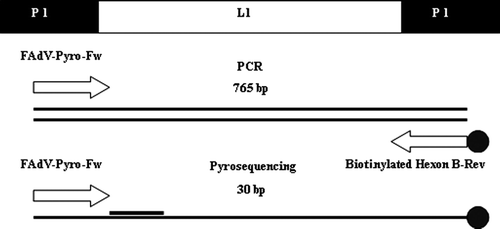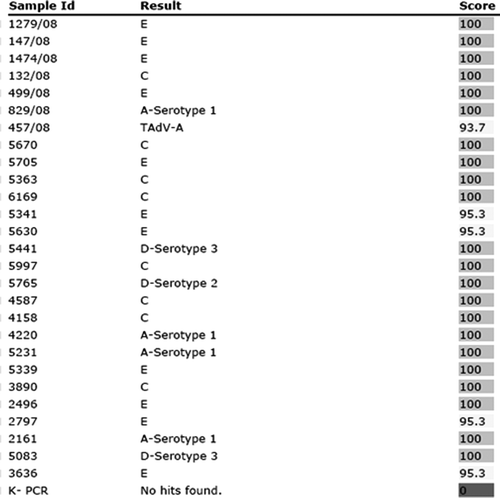Figures & data
Table 1. FAdV reference strains used in the present study.
Figure 1. Schematic representation of the P1 and L1 regions of the FAdV hexon gene and the primers used in this study for PCR reaction and pyrosequencing analysis.

Table 2. Pyrosequencing report of 22 reference strains representing the five FAdV species (A to E) and the 12 different serotypes.
Table 3. Comparison between the BLASTn and the pyrosequence results of the 27 field isolates.
Figure 2. Agarose gel electrophoresis of the 740 to 765 bp PCR products from single FAdV strains representing FAdV serotypes 1 to 11 and control samples using HEV, EDS'76, ILTV, IBV strain M41, AIV subtype H7 and non-template control (K–). MW, molecular weight.

Figure 3.
Phylogenetic tree established with the nucleotide sequences of the approximately 765 bp fragment of the reference strains hexon L1 region. The FAdVs are clustered into five species (A to E) and then divided into 12 serotypes according to the ICTV current nomenclature (ICTVdB Management, Citation2006). Serotypes: ![]()

Figure 4. Example of pyrogram showing the 30-bp sequence of the hexon L1 of a reference strain (506). The pyrophosphate anion (P2O7 4-, PPi) is released by the hydrolysis of ATP into AMP when a nucleotide is incorporated into a growing DNA strand by the polymerase. Peak height is proportional to the amount of PPi and thereby to the number of incorporated nucleotides.

Figure 5. IdentiFire report of 27 field samples collected in the north-east of Italy between 2007 and 2008. This approach also allowed the identification of a Turkey adenovirus A isolate (sample number 457/08) of a distinct genogroup. No pyrosequencing reaction was observed for the non-template PCR controls (K–). The results column shows the FAdV species and serotype from the sequence library to which the tested samples shares homology in the 30-bp pyrosequencing region. The degree of homology is reflected by the score, which is given as a percentage.
